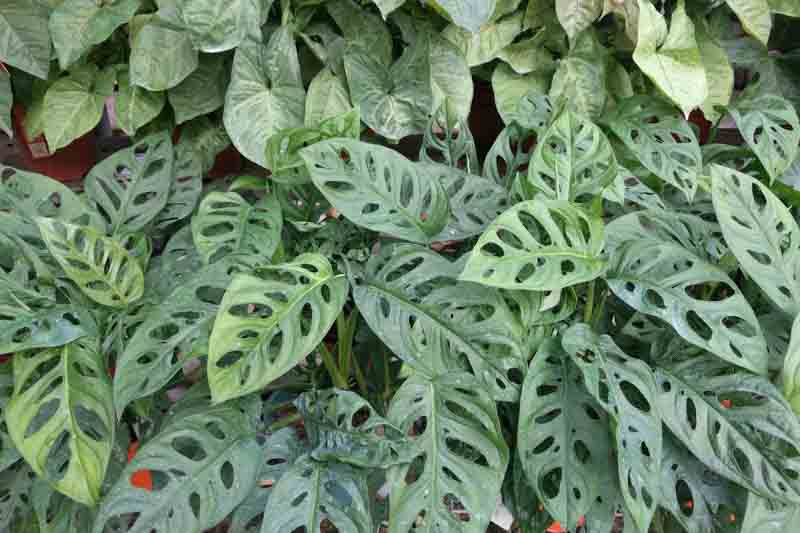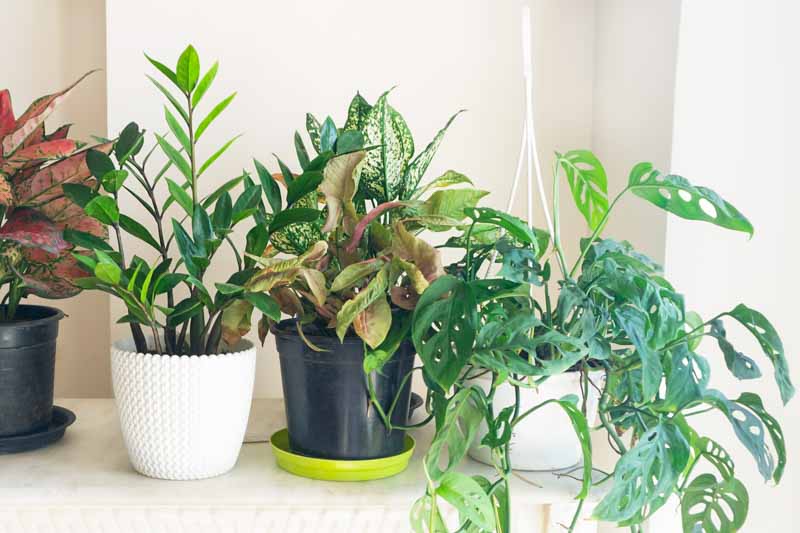Swiss Cheese Plant, Adanson's Monstera, Five Holes Plant
Monstera adansonii, commonly known as the Swiss cheese plant, is a fascinating and popular houseplant known for its unique, perforated leaves.
Monstera adansonii is characterized by its distinctive, heart-shaped leaves adorned with oval holes, earning it the nickname “Swiss cheese plant or Five Hole Plant.” These holes are not only visually striking but also allow light to pass through to the lower leaves in its natural dense rainforest environment
Native: Native to the tropical rainforests of Central and South America, Monstera adansonii thrives in warm, humid conditions. It’s found in countries ranging from Mexico to Bolivia, growing as an epiphyte or terrestrial plant. It belongs to the arum family (Araceae), along with Zantedeschia (Calla Lily), Caladium (Angel Wing), or Colocasia (Elephant Ear).
Plant Type and Habit: This species is a climbing evergreen perennial. In the wild, it uses aerial roots to attach itself to larger trees, gradually climbing towards the canopy to access more light.
Size: When grown indoors, Monstera adansonii can reach up to 3-8 feet in height (90-240 cm) and 1-3 feet in spread (30-90 cm), depending on the support provided for its climbing habit. Outdoors, it can grow 10-13 feet tall (3-4 meters).
Foliage: The foliage of Monstera adansonii is its most striking feature. The leaves are medium to dark green, heart-shaped, and filled with natural holes. These leaves can grow up to 18 inches wide (45 cm) in the wild, though they are usually smaller indoors.
Hardiness: Monstera adansoni is hardy in USDA zones 10-12, thriving in warm, humid conditions.
Uses: This Monstera is primarily used for ornamental purposes and is appreciated for its unique appearance and air-purifying qualities. It’s a popular choice for indoor gardens, terrariums, and as a statement plant in interior design.
Toxicity: This plant is toxic to humans, cats, and dogs if ingested. It contains calcium oxalate crystals that can cause mouth and stomach irritation. Contact with the sap may cause skin irritation.
Deer and Rabbits: Its toxicity generally deters deer and rabbits.
Invasiveness: Monstera adansonii is not considered invasive in most areas. In some tropical regions outside its native range, any Monstera species should be cautiously grown to prevent escape into local ecosystems.
Benefits: Beyond its decorative appeal, Monstera adansonii can help purify the air. It’s also believed to contribute to a relaxing and calming environment, making it a favorite among houseplant enthusiasts.

Growing and caring for Monstera, a striking tropical plant, is relatively straightforward, making it a popular choice for indoor gardeners.
Light: Monstera adansonii prefers bright, indirect sunlight to thrive. Direct sunlight can scorch its leaves, while too little light may reduce leaf perforations and growth. An east or west-facing window providing filtered light is ideal for this tropical plant.
Soil: Use a peat-based potting mix with perlite or sand to improve drainage. Monsteras prefer slightly acidic to neutral pH.
Water: Water when the top inch of soil feels dry. Monsteras like evenly moist soil but not soggy. Reduce watering in winter.
Temperature and Humidity: Ideal temperatures range from 68°F to 86°F (20°C to 30°C). Avoid exposure to temperatures below 50°F (10°C), as cold can damage the plant. Thrives in humidity levels of 50%. Use a humidifier or mist the leaves regularly to increase humidity, especially in dry environments.
Fertilization: Apply a balanced, water-soluble fertilizer monthly during the growing season (spring through summer). Reduce to every other month in fall and winter.
Pruning: Prune in spring or early summer to maintain size and shape. Remove any yellow or damaged leaves to encourage new growth.
Cleaning: Dust the leaves occasionally with a damp cloth to ensure the plant can photosynthesize efficiently. This also keeps the plant looking its best.
Repotting: Repot every 2-3 years or when the plant becomes rootbound. Choose a pot 1-2 inches larger in diameter than the current one.
Climbing Support: Provide a moss pole or trellis for support, mimicking its natural climbing habit. Attach stems loosely to the support as they grow.

Red aglonema (Chinese Evergreen Plant), ZZ plant (Zamioculcas zamiifolia), Pink syngonium, monstera adansonii
Propagating Monstera is a rewarding and straightforward process that allows you to create new plants from an existing one.
Monstera can encounter pests, diseases, and other common problems, especially when grown indoors.
Spider Mites: These tiny pests cause yellow stippling on leaves. Increase humidity and wash leaves with water or use insecticidal soap.
Mealybugs: Look for cottony deposits in leaf axils or undersides. Remove with alcohol-dipped cotton swabs or apply neem oil.
Aphids: Small, pear-shaped pests that cluster on new growth and undersides of leaves, sucking plant sap and weakening it. Combat them with a gentle spray of water, neem oil, or insecticidal soap to protect the plant’s health and appearance.
Scale insects: Hard, brown bumps on leaves/stems indicate scale. Scrape off manually and treat with neem oil or insecticidal soap.
Root rot: Overwatering can lead to root rot, characterized by mushy, brown roots and yellowing leaves. Ensure good drainage and allow soil to dry between waterings.
Leaf spot: Fungal or bacterial leaf spots appear as discolored patches on leaves. Improve air circulation, avoid wetting foliage, and treat with fungicides if severe.
Yellowing Leaves: Overwatering, poor drainage, or nutrient deficiencies can cause leaves to yellow. Adjust watering habits and consider repotting or fertilizing.
Brown Leaf Tips/Edges: Low humidity or drought stress might cause brown tips. Increase humidity around the plant with a pebble tray or humidifier.
Leggy Growth: Insufficient light can lead to sparse, leggy growth. Move your Monstera to a brighter location with indirect sunlight.
Fenestration Not Developing: Young plants or those not receiving enough light may not develop the characteristic leaf holes or splits. Provide brighter indirect light to encourage fenestration.
| Hardiness |
10 - 12 |
|---|---|
| Plant Type | Houseplants, Climbers, Perennials |
| Plant Family | Araceae |
| Genus | Monstera |
| Exposure | Partial Sun |
| Season of Interest |
Spring (Early, Mid, Late) Summer (Early, Mid, Late) Fall Winter |
| Height |
3' - 13' (90cm - 4m) |
| Spread |
1' - 3' (30cm - 90cm) |
| Maintenance | Low |
| Water Needs | Average |
| Soil Type | Loam |
| Soil pH | Acid, Neutral, Alkaline |
| Soil Drainage | Moist but Well-Drained |
| Characteristics | Showy, Evergreen |
| Tolerance | Deer, Rabbit |
| Garden Uses | Patio And Containers |
| Hardiness |
10 - 12 |
|---|---|
| Plant Type | Houseplants, Climbers, Perennials |
| Plant Family | Araceae |
| Genus | Monstera |
| Exposure | Partial Sun |
| Season of Interest |
Spring (Early, Mid, Late) Summer (Early, Mid, Late) Fall Winter |
| Height |
3' - 13' (90cm - 4m) |
| Spread |
1' - 3' (30cm - 90cm) |
| Maintenance | Low |
| Water Needs | Average |
| Soil Type | Loam |
| Soil pH | Acid, Neutral, Alkaline |
| Soil Drainage | Moist but Well-Drained |
| Characteristics | Showy, Evergreen |
| Tolerance | Deer, Rabbit |
| Garden Uses | Patio And Containers |
How many Monstera adansonii (Swiss Cheese Plant) do I need for my garden?
| Plant | Quantity | |
|---|---|---|
| Monstera adansonii (Swiss Cheese Plant) | N/A | Buy Plants |
Create a membership account to save your garden designs and to view them on any device.
Becoming a contributing member of Gardenia is easy and can be done in just a few minutes. If you provide us with your name, email address and the payment of a modest $25 annual membership fee, you will become a full member, enabling you to design and save up to 25 of your garden design ideas.
Join now and start creating your dream garden!
Create a membership account to save your garden designs and to view them on any device.
Becoming a contributing member of Gardenia is easy and can be done in just a few minutes. If you provide us with your name, email address and the payment of a modest $25 annual membership fee, you will become a full member, enabling you to design and save up to 25 of your garden design ideas.
Join now and start creating your dream garden!